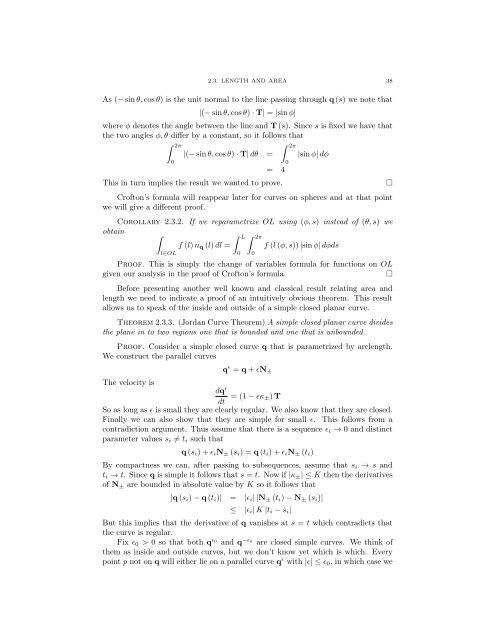Lecture Notes for 120 - UCLA Department of Mathematics
Lecture Notes for 120 - UCLA Department of Mathematics
Lecture Notes for 120 - UCLA Department of Mathematics
You also want an ePaper? Increase the reach of your titles
YUMPU automatically turns print PDFs into web optimized ePapers that Google loves.
As (<br />
2.3. LENGTH AND AREA 38<br />
sin ✓, cos ✓) is the unit normal to the line passing through q (s) we note that<br />
|( sin ✓, cos ✓) · T| = |sin |<br />
where denotes the angle between the line and T (s). Sinces is fixed we have that<br />
the two angles , ✓ differ by a constant, so it follows that<br />
ˆ 2⇡<br />
0<br />
|( sin ✓, cos ✓) · T| d✓ =<br />
= 4<br />
This in turn implies the result we wanted to prove.<br />
ˆ 2⇡<br />
Cr<strong>of</strong>ton’s <strong>for</strong>mula will reappear later <strong>for</strong> curves on spheres and at that point<br />
we will give a different pro<strong>of</strong>.<br />
Corollary 2.3.2. If we reparametrize OL using ( , s) instead <strong>of</strong> (✓, s) we<br />
obtain ˆ<br />
ˆ L ˆ 2⇡<br />
f (l) n q (l) dl = f (l ( , s)) |sin | d ds<br />
l2OL<br />
0<br />
Pro<strong>of</strong>. This is simply the change <strong>of</strong> variables <strong>for</strong>mula <strong>for</strong> functions on OL<br />
given our analysis in the pro<strong>of</strong> <strong>of</strong> Cr<strong>of</strong>ton’s <strong>for</strong>mula.<br />
⇤<br />
Be<strong>for</strong>e presenting another well known and classical result relating area and<br />
length we need to indicate a pro<strong>of</strong> <strong>of</strong> an intuitively obvious theorem. This result<br />
allows us to speak <strong>of</strong> the inside and outside <strong>of</strong> a simple closed planar curve.<br />
Theorem 2.3.3. (Jordan Curve Theorem) A simple closed planar curve divides<br />
the plane in to two regions one that is bounded and one that is unbounded.<br />
Pro<strong>of</strong>. Consider a simple closed curve q that is parametrized by arclength.<br />
We construct the parallel curves<br />
0<br />
q ✏ = q + ✏N ±<br />
The velocity is<br />
dq ✏<br />
dt =(1 ✏apple ±) T<br />
So as long as ✏ is small they are clearly regular. We also know that they are closed.<br />
Finally we can also show that they are simple <strong>for</strong> small ✏. This follows from a<br />
contradiction argument. Thus assume that there is a sequence ✏ i ! 0 and distinct<br />
parameter values s i 6= t i such that<br />
0<br />
|sin<br />
q (s i )+✏ i N ± (s i )=q (t i )+✏ i N ± (t i )<br />
By compactness we can, after passing to subsequences, assume that s i ! s and<br />
t i ! t. Sinceq is simple it follows that s = t. Nowif|apple ± |appleK then the derivatives<br />
<strong>of</strong> N ± are bounded in absolute value by K so it follows that<br />
|q (s i ) q (t i )| = |✏ i ||N ± (t i ) N ± (s i )|<br />
apple |✏ i | K |t i s i |<br />
But this implies that the derivative <strong>of</strong> q vanishes at s = t which contradicts that<br />
the curve is regular.<br />
Fix ✏ 0 > 0 so that both q ✏0 and q ✏0 are closed simple curves. We think <strong>of</strong><br />
them as inside and outside curves, but we don’t know yet which is which. Every<br />
point p not on q will either lie on a parallel curve q ✏ with |✏| apple✏ 0 , in which case we<br />
| d<br />
⇤
















